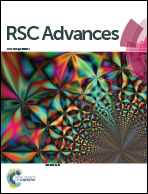Prospective aspects of preferential {001} facets of N,S-co-doped TiO2 photocatalysts for visible-light-responsive photocatalytic activity†
Abstract
In this report, we describe the synthesis of nitrogen and sulfur co-doped TiO2 photocatalysts (NST) with preferential {001} facets by surfactant- and template-free OPM routes and crystallized through hydrothermal treatment. The precursor solution formed a coordination complex containing Ti–peroxo complex and chelating ligands (thiourea and urea were used as ligands for sulfur and nitrogen-donating sources, respectively). The effects of dopant concentration on the structural and morphological properties of the as-prepared NST photocatalysts were studied using X-ray diffraction (XRD), X-ray photoelectron spectroscopy (XPS), field emission scanning electron microscopy (FE-SEM), high-resolution transmission electron microscopy (HR-TEM), N2-adsorption–desorption isotherms and defuse reflectance spectroscopy (DRS). The visible-light-driven photocatalytic activity of the as-prepared NST samples was tested for the photodegradation of organic compounds (i.e. rhodamine B and phenol). High-performance liquid chromatography (HPLC) and LC-MS spectroscopy were used to analyze the by-products from the photodegradation of RhB. Different scavengers were added to the photocatalysis system in order to identify the role of active species in the photodegradation of organic compounds on the surface of NST photocatalysts. It was found that hydroxyl radicals (˙OH) and photogenerated holes (h+) played an important role in the photodegradation of organic compounds under visible-light irradiation. The electronic and structural characterizations of the as-prepared NST samples proved the successful incorporation of dopant elements (i.e. N and S) into the crystal lattice of TiO2 – which shifted the absorption edge shoulder from UV to the visible-light region, due to the bandgap transition. Another reason for the red shift of the absorption edge in the visible-light region is expected to be the formation of new energy levels near to the conduction bands, because of the incorporation of dopant elements (N and S) into the bandgap of the TiO2 crystal lattice. More interestingly, the pristine NST-0 sample showed photocatalytic activity, expected to be due to the formation of a substrate–surface complexation, resulting in an absorption shift of TiO2 into the visible light region due to the transfer of charges from the ligand (i.e. the attached dye molecule) to the titanium atoms. Moreover, the photocatalytic efficiency of the as-prepared NST samples was higher than those of the other samples. The prominent synergetic factors responsible for enhanced photocatalytic activity of doped NST samples include: (1) the presence of preferential exposed {001} facets of the anatase TiO2 nanorods, and (2) the introduction of the shift in the absorption edge shoulder towards the visible-light region. The preferential {001} facets act as a reservoir for the photogenerated charge carriers (i.e. electron–hole pairs) and slow down their rate of recombination. The introduction of absorption shift facilitates the adsorption of organic compounds on the photocatalyst surface.



 Please wait while we load your content...
Please wait while we load your content...